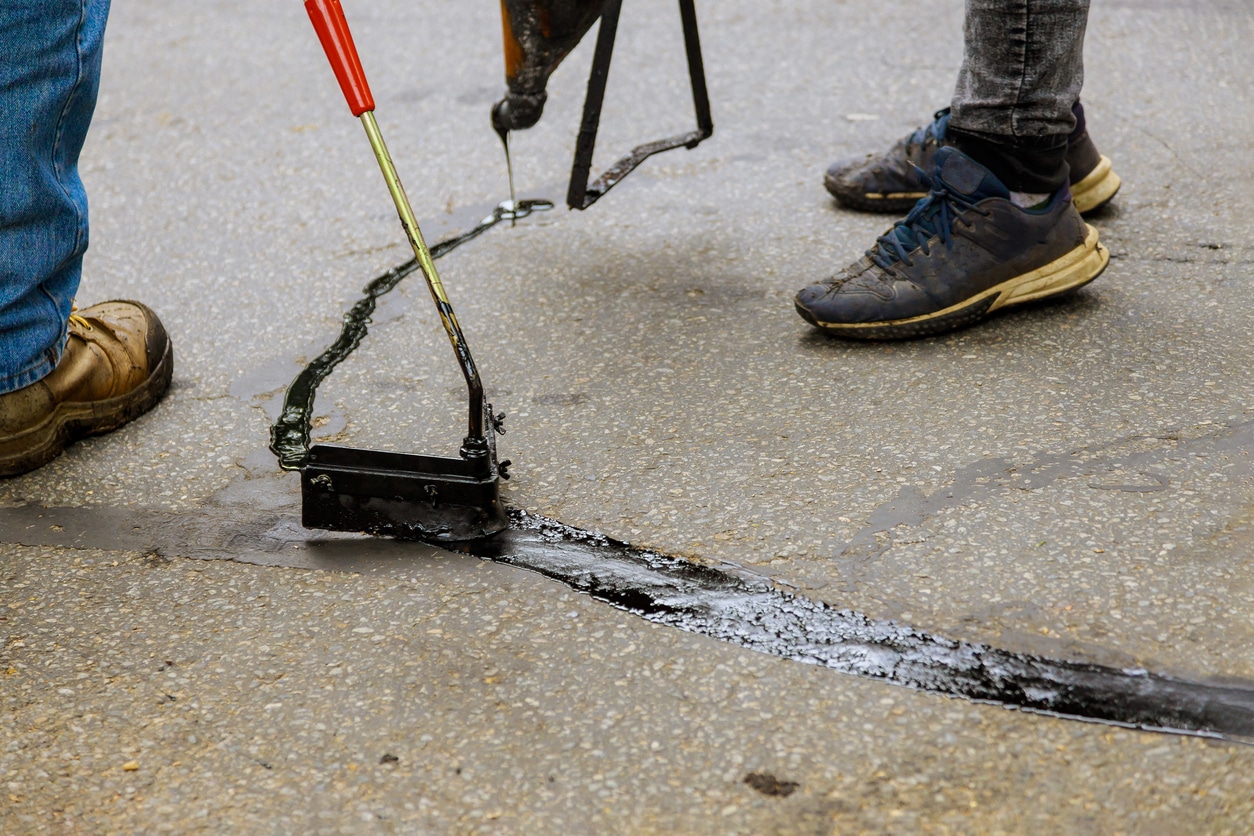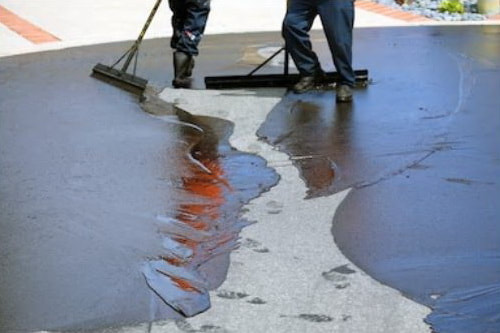Understanding Angled Parking: How Asphalt Sealing Boosts Commercial Whole Lots
Understanding Angled Parking: How Asphalt Sealing Boosts Commercial Whole Lots
Blog Article
Hot Mix Asphalt: A Sustainable Service for Pavement
Hot Mix Asphalt (HMA) has emerged as a leading lasting choice for sidewalk solutions, supplying a myriad of innovative innovations and ecological advantages. Its ability to reuse materials and minimize power usage offers a compelling situation for its adoption in roadway construction projects. Additionally, the lasting performance and toughness of HMA make it a favored option for framework growth. As the need for green building practices expands, discovering the subtleties of HMA's sustainability can give important insights right into the future of sidewalk remedies.
Environmental Advantages of Hot Mix Asphalt

Furthermore, Warm Mix Asphalt aids to reduce city warm island impacts. Its dark shade soaks up sunlight, reducing the quantity of warmth mirrored back right into the ambience compared to lighter-colored pavements. This can decrease ambient temperatures in metropolitan areas, reducing the demand for a/c and ultimately minimizing power usage.
Furthermore, Hot Mix Asphalt adds to boosted stormwater monitoring. Its permeable nature permits water to charge and penetrate the sidewalk groundwater materials, reducing overflow and the risk of flooding. These ecological benefits make Warm Mix Asphalt a sustainable option for paving roadways and freeways.
Energy Performance in HMA Manufacturing
Is energy efficiency an essential element in the production of Hot Mix Asphalt (HMA)? Absolutely. Energy plays a substantial duty in the manufacturing of HMA, impacting both expense and ecological sustainability. One crucial element of energy performance in HMA manufacturing is using cozy mix asphalt (WMA) technologies (commercial parking lot paving). WMA enables the mixing and placement of asphalt at reduced temperatures contrasted to typical warm mix asphalt, resulting in reduced power usage during manufacturing. This process not only decreases fuel usage yet additionally lowers greenhouse gas discharges, making it a more ecologically friendly choice.
Moreover, innovations in plant innovations have brought about more energy-efficient HMA manufacturing procedures. Modern plants are made with attributes like recycled asphalt sidewalk (RAP) processing capacities, reliable burner systems, and improved insulation, all adding to energy savings. By enhancing energy use in HMA manufacturing, the sector can lower its carbon impact while preserving top notch pavement products. Energy effectiveness is, for that reason, an essential factor to consider in making sure the sustainability of Hot Mix Asphalt production.
Recyclability of Hot Mix Asphalt
The recyclability of Hot Mix Asphalt (HMA) is a critical aspect of its sustainability and long-term ecological influence. HMA is one of the most recycled materials in the USA, with over 100 million lots of recovered asphalt sidewalk (RAP) being reused every year in brand-new sidewalk building. Reusing HMA offers numerous ecological advantages, such as decreasing the requirement for virgin products, lowering energy usage throughout manufacturing, and reducing the amount of waste sent out to landfills.
The process of recycling HMA includes milling the existing sidewalk, crushing it right into smaller sized items, and mixing it with new accumulation and asphalt binder to create a recycled mix. This recycled mix can often perform as well as or perhaps much better than traditional HMA, while calling for less basic materials and producing lower he has a good point greenhouse gas discharges. By incorporating RAP into brand-new pavement jobs, roadway firms can preserve natural deposits, reduce prices, and reduce the ecological footprint of road building and construction and upkeep activities. In general, the recyclability of HMA plays a substantial duty in promoting lasting methods within the pavement sector.

Long-Term Performance of HMA
Asphalt pavements show resilience and durability over an extended duration, reflecting the long-lasting efficiency of Hot Mix Asphalt (HMA) The long life of HMA can be connected to its ability to stand up to rush hour tons, severe weather problems, and the impacts of aging. Researches have actually revealed that properly designed and appropriately created HMA pavements can last for twenty years or more with routine upkeep. The key to taking full advantage of the lasting performance of HMA exists in utilizing top quality materials, following best methods in construction, read this post here and carrying out effective upkeep approaches. Correct water drainage, regular evaluations, and prompt fixings are necessary for maintaining the architectural integrity of HMA sidewalks over time. In addition, advancements in HMA modern technology, such as making use of polymer-modified binders and cozy mix asphalt, have actually better boosted the durability and longevity of HMA pavements. By prioritizing top quality building and maintenance methods, HMA remains to prove itself as a sustainable and cost-efficient option for resilient pavement facilities.

HMA: Toughness and Sustainability
Showing both toughness and sustainability, Hot Mix Asphalt (HMA) has actually become a cornerstone in the construction of resilient pavement facilities - commercial parking lot paving. HMA's durability stems from its capability to hold up against heavy tons, extreme climate condition, and high web traffic volumes, making it a dependable option for streets, highways, and airport runways. The structure of HMA, which typically consists of accumulations, binder, and filler, plays an important duty in boosting its durability and resistance to tear and wear
Furthermore, HMA's sustainability lies in its recyclability and energy-efficient production process. The capability to reuse recovered asphalt pavement (RAP) in brand-new HMA blends minimizes the need for virgin materials and minimizes the ecological impact of sidewalk construction and upkeep. Additionally, the energy effectiveness of generating HMA hinges on its recommended you read lower mixing temperature levels compared to other sidewalk products, causing decreased power usage and greenhouse gas exhausts.
Verdict
Finally, hot mix asphalt (HMA) supplies a lasting solution for pavement with its environmentally pleasant qualities. HMA's recyclability, power effectiveness in production, and long-term longevity make it an eco-friendly option for roadway building. By conserving natural sources, minimizing waste, and decreasing greenhouse gas exhausts, HMA plays an important function in advertising sustainability in infrastructure development. Its capacity to mitigate urban warm island results even more highlights its significance in creating resilient and ecologically aware sidewalk systems.
HMA is one of the most recycled products in the United States, with over 100 million bunches of redeemed asphalt sidewalk (RAP) being recycled yearly in brand-new pavement construction.The procedure of recycling HMA entails grating the existing sidewalk, squashing it into smaller items, and blending it with brand-new accumulation and asphalt binder to produce a recycled mix.Asphalt sidewalks show toughness and strength over a prolonged duration, showing the long-term efficiency of Hot Mix Asphalt (HMA) Furthermore, innovations in HMA technology, such as the usage of polymer-modified binders and cozy mix asphalt, have further enhanced the resilience and long life of HMA pavements. The capability to reuse reclaimed asphalt sidewalk (RAP) in brand-new HMA mixtures decreases the need for virgin materials and lessens the environmental effect of pavement building and upkeep.
Report this page